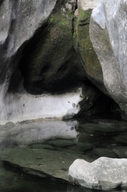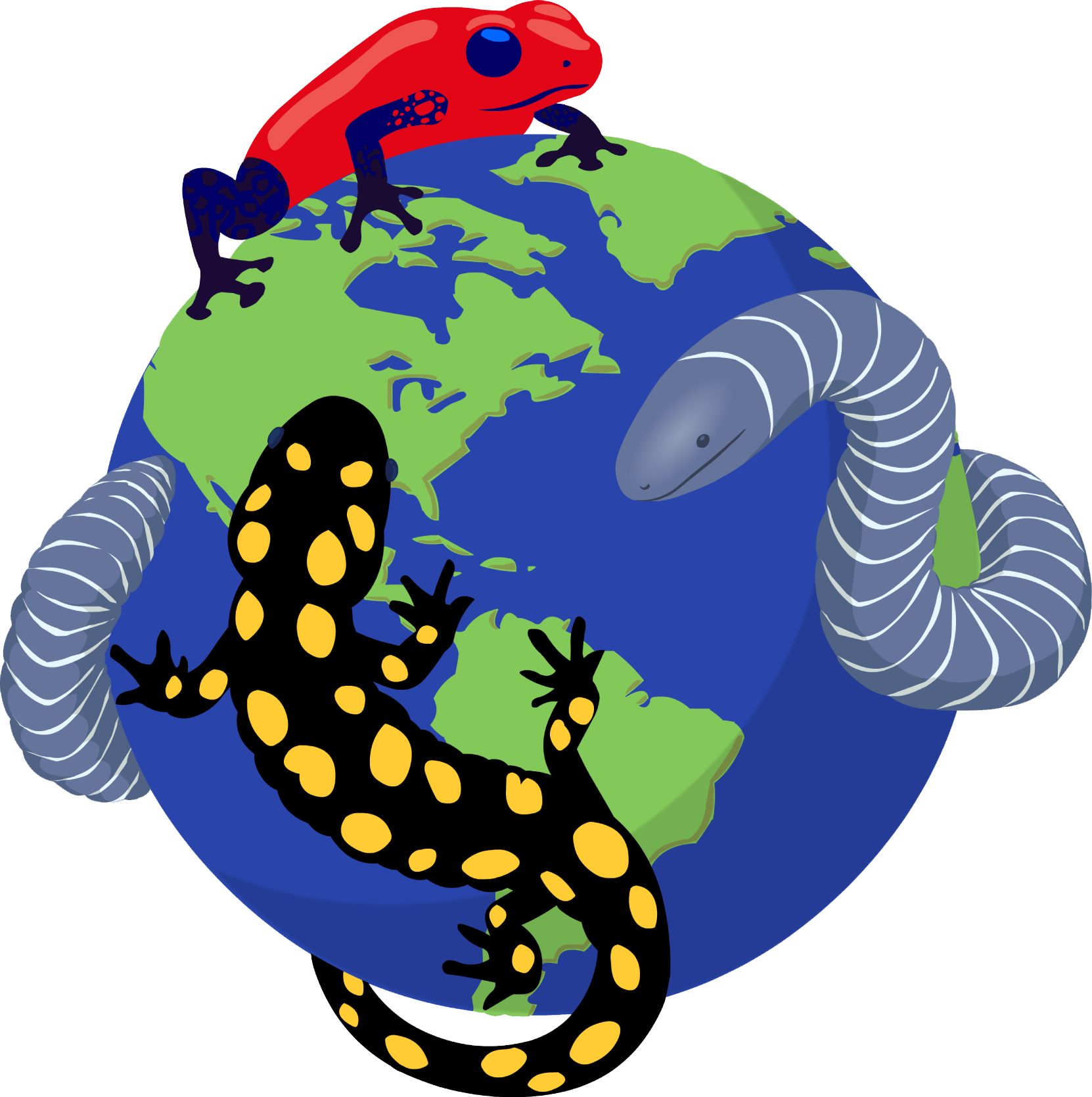|
Description
Small frog with relatively large head. Males attain a snout-vent length of up
to 34,7mm, whereas females grow up to 38 mm. The eyes are large and have a
vertical slit-shaped pupil. Limbs, fingers and toes are relatively long.
There are three metacarpal tubercles. The skin is fairly smooth and shiny.
Some larger warts are present along the sides of the back. The coloration
is very variable. Usually there are dark green to black spots of variable
size and shape on a golden-greenish background. Not seldom there is a
black triangle present on the head behind the eyes. The underside is white.
There is no clear sexual dimorphism. (Noellert and Noellert 1992).
Distribution and Habitat
Country distribution from AmphibiaWeb's database: Spain
Alytes muletensis is endemic to Mallorca a small island off the eastern coast of Spain. The species was first
described from fossils in the upper pleistocene as Baleaphryne muletensis
Sanchiz and Adrover, 1977. It was believed to have gone extinct following the
colonization of the island by man about 4000BC, until larvae and young frogs
were found in the inaccessible limestone gorges of the Serra de Tramuntana
(Buley and Garcia 1997).
The species is found in only ten brooks (torrentes) in the Serra de Tramuntana.
The area receives an annual rainfall of 1000 to 2000mm. Water temperatures
range from 9ºC to 22ºC. The frogs hide in crevices and under stones in groups
of up to 5 individuals.
Life History, Abundance, Activity, and Special Behaviors
Mating behaviour is similar to other Alytesspecies. Male call sounds
like a high melodic "pi..pi..pi..". Like in the rest of the genus Alytes,
the males of this species carry the eggs in strings around their ankles until
the tadpoles hatch. Males bearing eggs are found mostly in May and June.
The eggs in this species are larger than those of other Alytes,
but smaller in number. The eggs measure 5.4 to 7mm in diameter and a clutch
contains 7 to 12 eggs. The first larvae hatch in the beginning of May. Total
length upon hatching is 18mm, and the larvae grow up to 76mm in a few weeks. Metamorphosis occurs mostly in June.
There is no hibernation period. These frogs are mostly active at night (Noellert and Noellert 1992).
Trends and Threats
Alytes muletensis is among the most important species in Europe from a
conservation viewpoint. The small occupied area, the low number of adults
(between 500 and 1500 pairs in all, according to various estimates) and the
evidence of a formerly much larger range - all bring this species to the
highest rank in the list of animals deserving special protective measures.
In fact, state and regional laws have forbidden the capture, keeping or
killing of this species since 1980. Listed on the Red Data Book of Spanish
Vertebrates as endangered, the species' rarity has also been acknowledged
by all international conservation agreements signed by Spain. The habitat
was put forward as a Biogenetic Reserve to the council of Europe, and the
species has been subject to two recovery programs, one of them involving
breeding of captive animals. In spite of that, the future of the species
looks bleak. Dangers are too high, and populations too scarce and small
to withstand a serious threat. So far, animals introduced by man have been
the main enemies of the toad. Especially dangerous is the snake
Natrix maura, an efficient predator of adults and tadpoles,
introduced by man in Roman times. Competition for food with Rana perezi
could be another factor of the past range decrease. Today,
Alytes muletensis lives only in places which both these species,
the snake and the frog, cannot reach. The heavy tourism in Mallorca
and the increase of urban population have resulted in a strong need for
water, to be taken from the only available place on the island,
the mountains of the north. There are already proposals to dam some of
the rivers where Alytes muletensis lives, and tap the water for
urban needs. It may be that breeding in captivity, which has already
allowed repopulating on some sites, will become, in the long term, the
only hope for survival of the species (Paris 1997).
Translocation of Alytes muletensis have had some measure of success (Seigel, 2001)
Possible reasons for amphibian decline Urbanization
Drainage of habitat
Predators (natural or introduced)
Introduced competitors
Comments
This species was featured in News of the Week December 14, 2015:
A paper by Bosch et al. 2015 has garnered much attention because of its strong claim: the research team eradicated Bd, the pathogenic fungus of amphibians, from the island of Mallorca in the western Mediterranean. The small island harbors a single species, Alytes muletensis, discovered only about 35 years ago, and there are few breeding sites, mostly in nearly inaccessible deep canyons. Bd appeared a few years ago, probably arriving through human agency, and threatened the species. The team used a common fungicide (itraconazole) and with considerable effort eliminated infection from organisms and the environment; it took five years but it worked – so far. While this is an important proof of concept, application to other parts of the world is problematic. Environmental impacts of the treatment are left unexplored, and the problems of multispecies communities, direct developing species, species with multi-year larvae, among other issues, may render this approach of limited value. (Written by David Wake)
References
Buley, K.R. and Garcia, G. (1997). ''The recovery programme for the Mallorcan midwife toad Alytes muletensis: An update.'' Dodo: Journal of the Jersey Wildlife Preservation Trusts, (33), 80-90.
Gasc, J.-P. (1997). Atlas of Amphibians and Reptiles in Europe. Societas Europaea Herpetologica, Bonn, Germany.
Nöllert, A. and Nöllert, C. (1992). Die Amphibien Europas. Franckh-Kosmos Verlags-GmbH and Company, Stuttgart.
Seigel, R. A. and Dodd, C.K., Jr. (2001). ''Translocations of amphibians: proven management method or experimental technique?'' Conservation Biology, 16(2), 552-554.
Stumpel-Rieks, S. E. (1992). Nomina Herpetofaunae Europaeae. AULA-Verlag, Wiesbaden.
Originally submitted by: Arie van der Meijden (first posted 1999-09-22)
Edited by: Vance T. Vredenburg, Michelle S. Koo (2021-11-05)Species Account Citation: AmphibiaWeb 2021 Alytes muletensis: Mallorcan Midwife Toad <https://amphibiaweb.org/species/1521> University of California, Berkeley, CA, USA. Accessed May 22, 2025.
Feedback or comments about this page.
Citation: AmphibiaWeb. 2025. <https://amphibiaweb.org> University of California, Berkeley, CA, USA. Accessed 22 May 2025.
AmphibiaWeb's policy on data use.
|





 Map of Life
Map of Life